There are a huge amount of plants that start with d, perfect for you plant lovers who can’t wait to get your hands on some.
It can be overwhelming when faced with the options of so many different gorgeous plants. In this article, we have helped you get all of the information you need into one place.
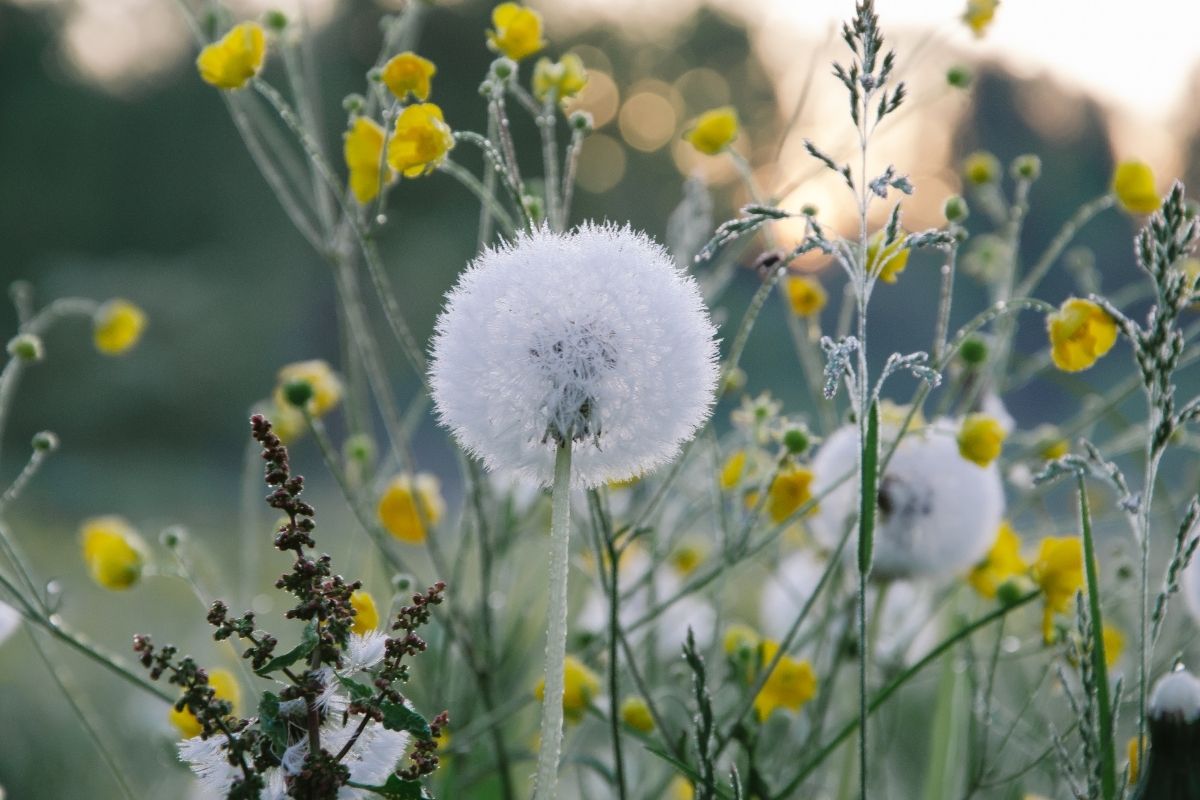
Whether it’s curiosity or passion that has led you here, I hope this article helps you in your green-fingered adventures!
1. Daffodil, Narcissus, Jonquil
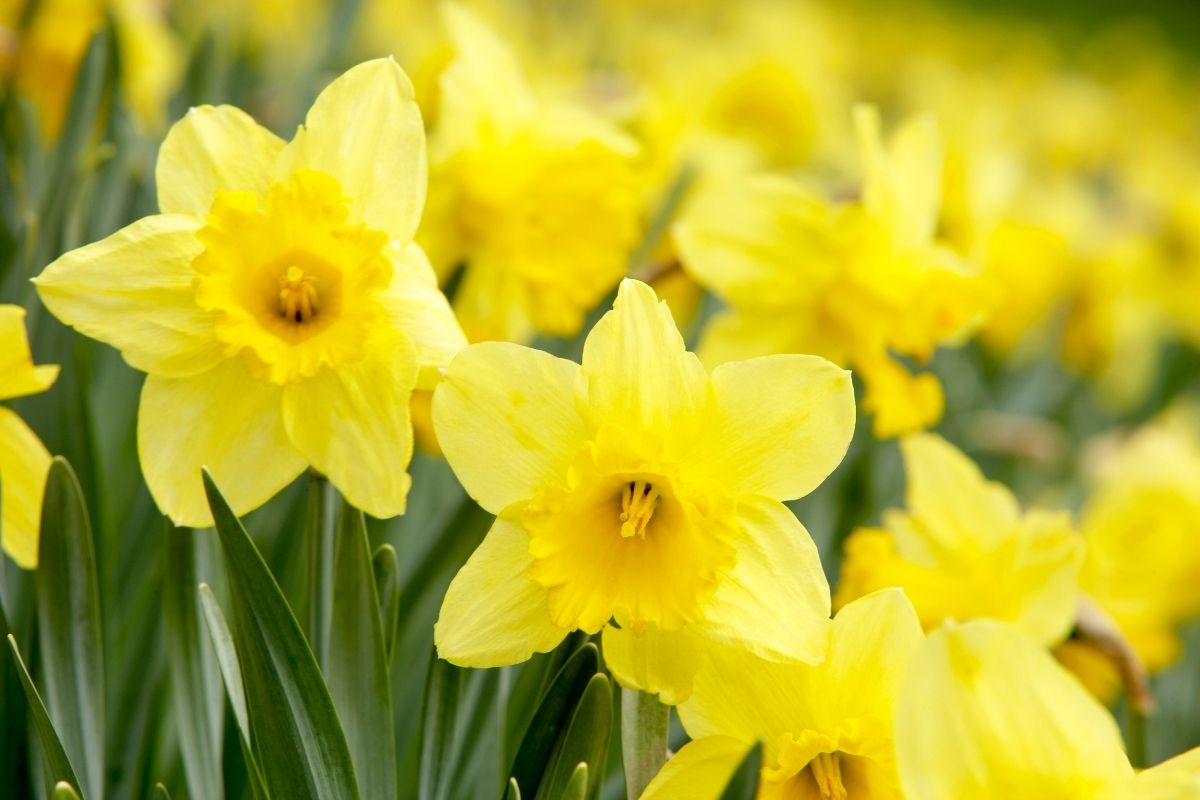
These lovely plants are Native to Western Europe, they are known to be the finest and most valuable spring bulbs for the South.
They live for long periods, naturally increasing year upon year. They respond to cold and heat by standing up. They offer an endearing array of flower forms, sizes, and colors. They are incredibly low maintenance and thrive all on their own.
They do not need summer watering and only need occasional division. Another great perk of this fascinating plant is that rodents and deer won’t eat them.
They start to flower in the winter in the Lower and Coastal South, and in early springtime elsewhere. The primary colors are shades of yellow and white, but orange, salmon, apricot, pink, green, and red can be found.
2. Dahlberg Daisy, Golden Fleece
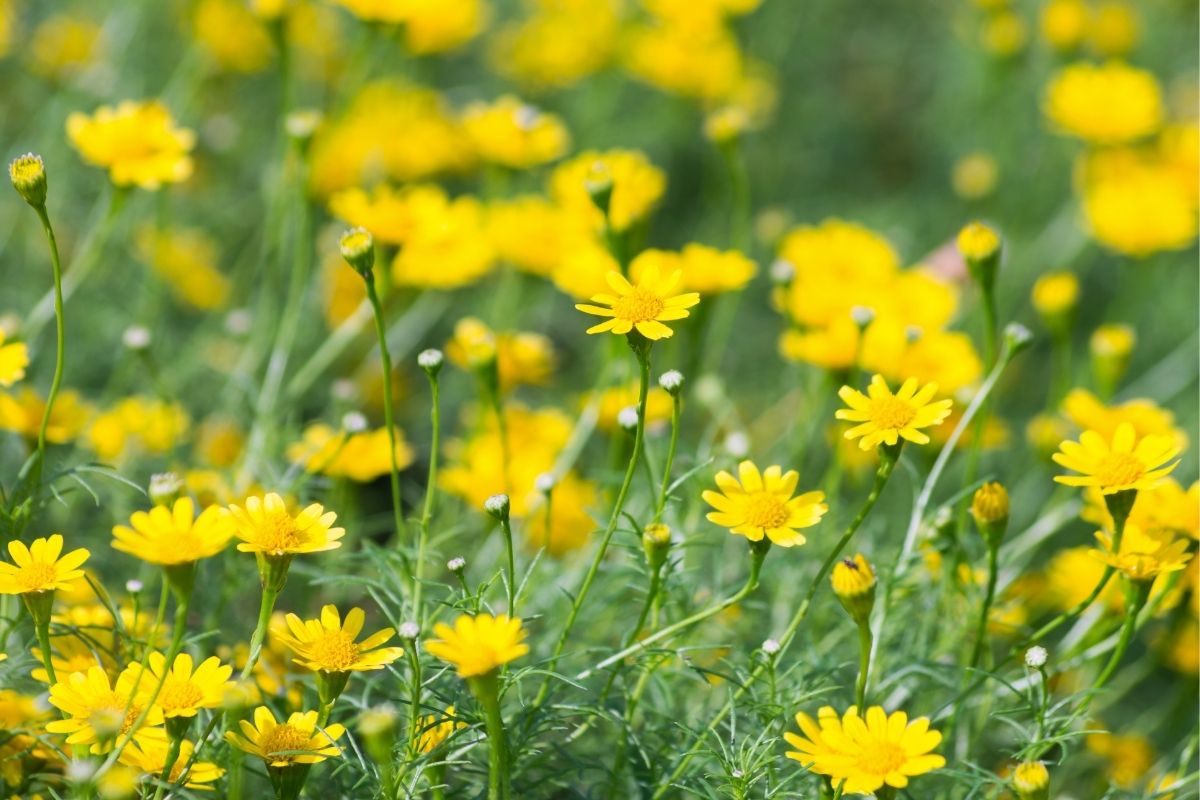
This plant loves the heat! Its native roots are from Texas to Florida and Mexico. They grow up to 1 foot high, and 112 feet wide.
When divided, the thin leaves make a dark green background for flowers that look like golden marguerites. These plants are commonly used for large displays or pockets of color.
This plant blooms from early summer to autumn. In warmer winter parts this plant can be planted in autumn for winter – springtime bloom.
This plant doesn’t seem to be fussy about its soil type but it likes good drainage. When the plants become ragged with age it’s time to pull them out.
3. Dahlia
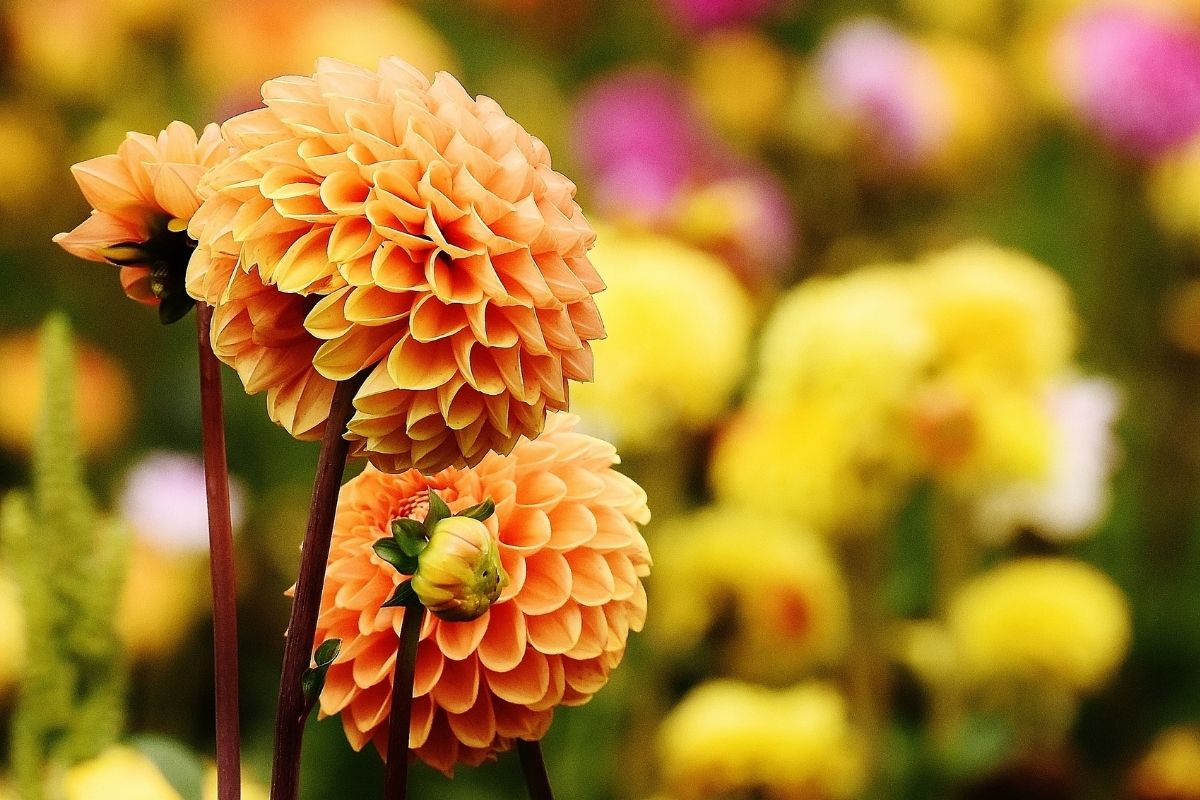
Dahlia’s originate from Mexico and Guatemala. Through centuries of adaptation and hybridizing, these plants have become very diversified.
They are available in numerous flower types and flower sizes and all colors except true blue. They range from 1 foot to 7 feet tall depending on bush or bedding dahlias.
The tall bush is a great summer hedge for privacy. The lower kinds provide mass color in borders of flower beds and gardens. They have strong stems and bloom for long periods facing outward or upwards.
4. Daisies And Sunflowers

Originally loved for their ornamental value, these plants offer lacy leaf patterns and aromatic, white leaves. These plants need good drainage.
They aren’t the best bet for places with high rainfall. Particularly along the Gulf Coast and in Florida.
These plants look great in mixed borders, as their white leaves beautifully soften the harsh edges of reds, oranges, blue and pink tones.
This is a popular old-fashioned favorite for Southern cottage gardens. The freely branched plant grows up to 3 feet tall and 3 feet wide.
They have 4 inch, toothed leaves, and clusters of 12 inches four-petaled lavender/purple blooms. These flowers look like those of stock and are very fragrant at night.
They grow readily from seed and often self-sow. When they get old and woody, they should be replaced with young seedlings.
White and double-flowered forms exist but are rare and luckily they are rarely damaged by passing deer.
5 . Dancing Girl Ginger
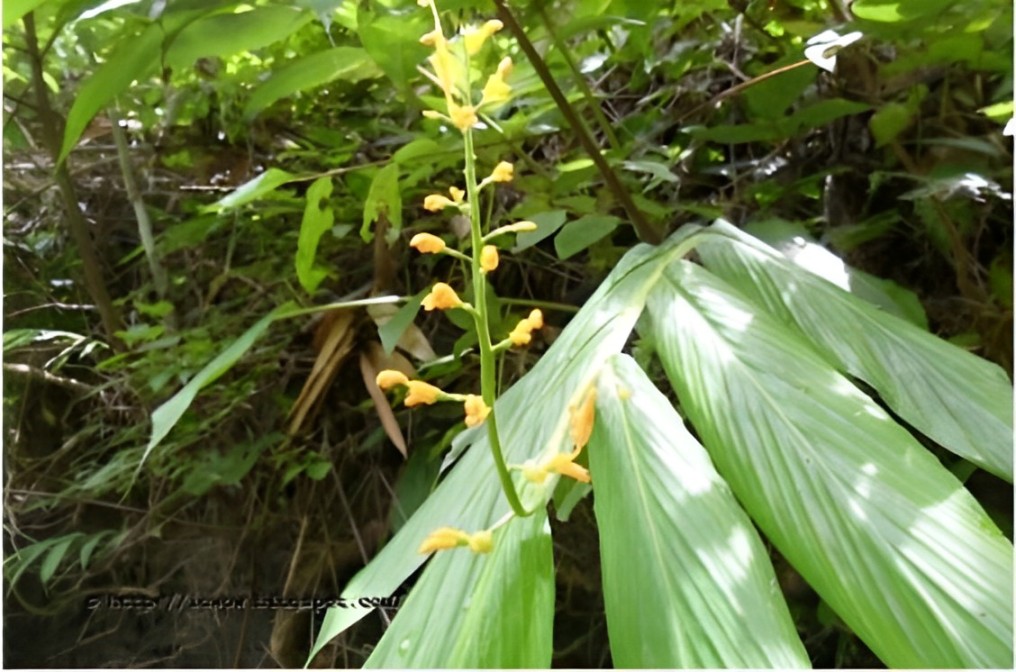
These beautifully delicate flowers of the ginger family are native to Southeast Asia. Amazingly they grow upright to 13 feet tall!
The leaves are lustrous green sheaths and beautiful flowers bloom in summer or fall among long, arching sprays of brightly colored bracts.
Bulbils are commonly found inside the bracts and if planted quickly, they will produce new plants.
It’s important to space them 112 feet apart. They need to be fertilized and kept moist during the growing season. It’s also important to feed them with a controlled release fertilizer in early spring and again in midsummer.
In the colder winter locations bring them inside before it frosts. You should stop watering them in the winter to give them a time of hibernation. Gradually resume watering in spring. Most of them make good-cut flowers.
6. Dandelion

The Pilgrims reportedly brought this plant to America from its homeland in northern Europe in the early 1600s. The reason is that the common dandelion is among the most nutritious and useful of herbs, with a great history of culinary and medicinal uses.
The leaves can be boiled or eaten fresh, they are high in potassium, iron, and vitamins A, C, B1, and B2. The dried roots make an excellent coffee substitute and the fermented flowers produce dandelion wine and beer.
Liver problems have been reported to be remedied by dandelion tonics. Beekeepers value dandelions as a rich source of nectar and pollen.
7. Daphne
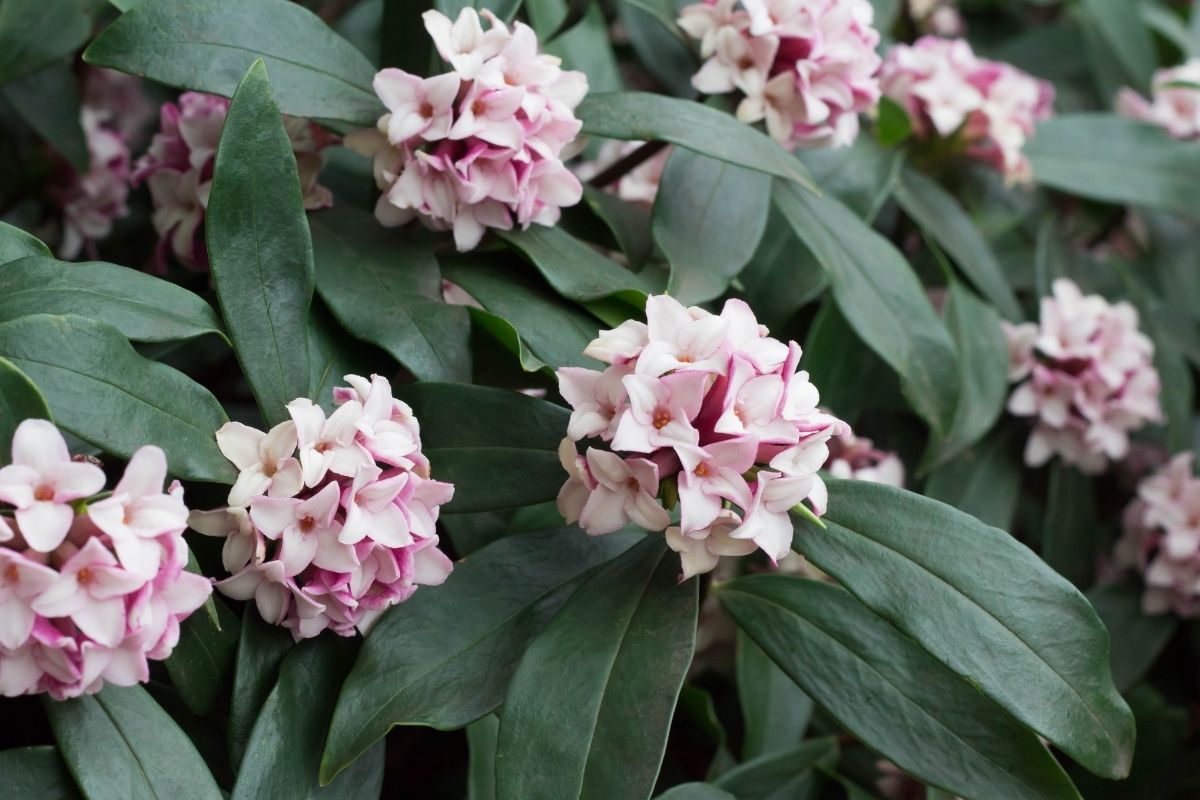
These beautiful shrubs should have a place in practically everyone’s garden. Having one or more on display earns you respect from the gardening crew!
Although some daphnes are easier to grow than others, they all require good drainage, cool soil (accomplished with mulch and light afternoon shade), an occasional watering during summer dry spells, and protection from the sun and wind.
Plants respond well to pruning but rarely need more than an occasional snip to fix their shape cut back to lateral branches or just above a growth bud. Cut branches can be forced into early bloom indoors in winter. Daphnes are not bothered by deer.
8. Date Palm
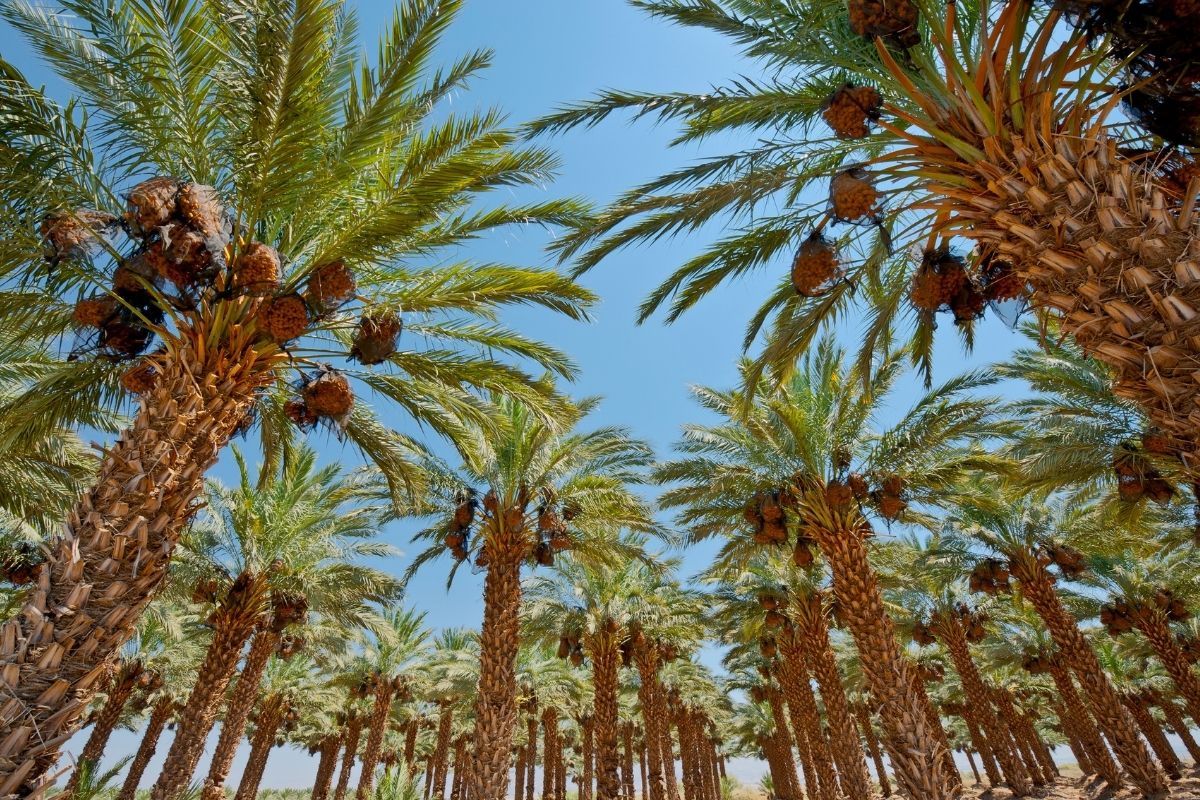
These feather palms are mostly large trees, though the following list includes two that grow less than 20 feet tall.
Trunks are patterned with bases of old leafstalks. Small, yellow flowers. On female trees, blossoms are followed by clusters of dates but only if the tree has been in the ground for at least several years and if a male tree is nearby.
9. Dawn Redwood
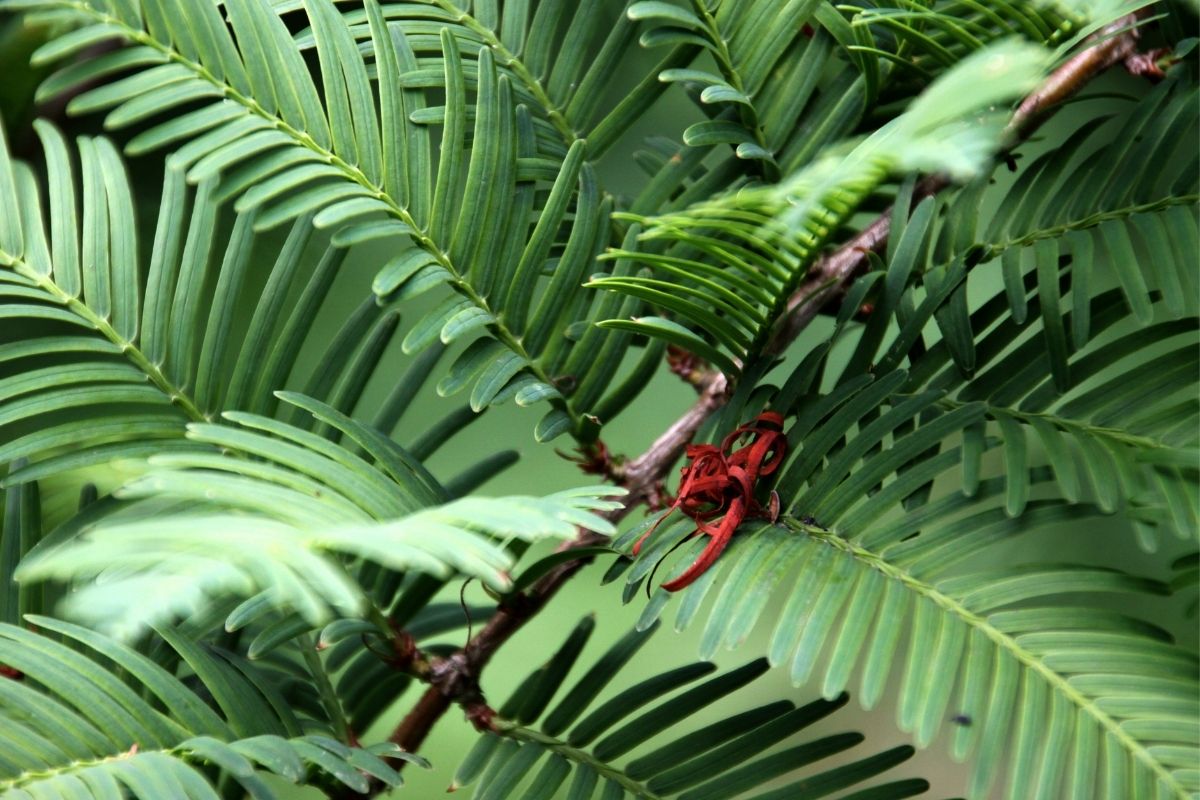
People thought this plant was extinct for thousands of years, this plant was found growing in a few isolated sites in its native China during the 1940s.
It is a pyramidal tree with small cones and soft, pale green needles that turn light orange-brown in autumn, then drop to show an attractive winter shape.
Branchlets tend to turn upward. Young trees have reddish bark; older ones have darker, fissured bark and rugged, fluted trunk bases.
Grows very fast when young, sometimes as much as 46 feet a year. Reaches about 90 feet tall and 20 feet wide at the age of 45 or so.
10. Daylily
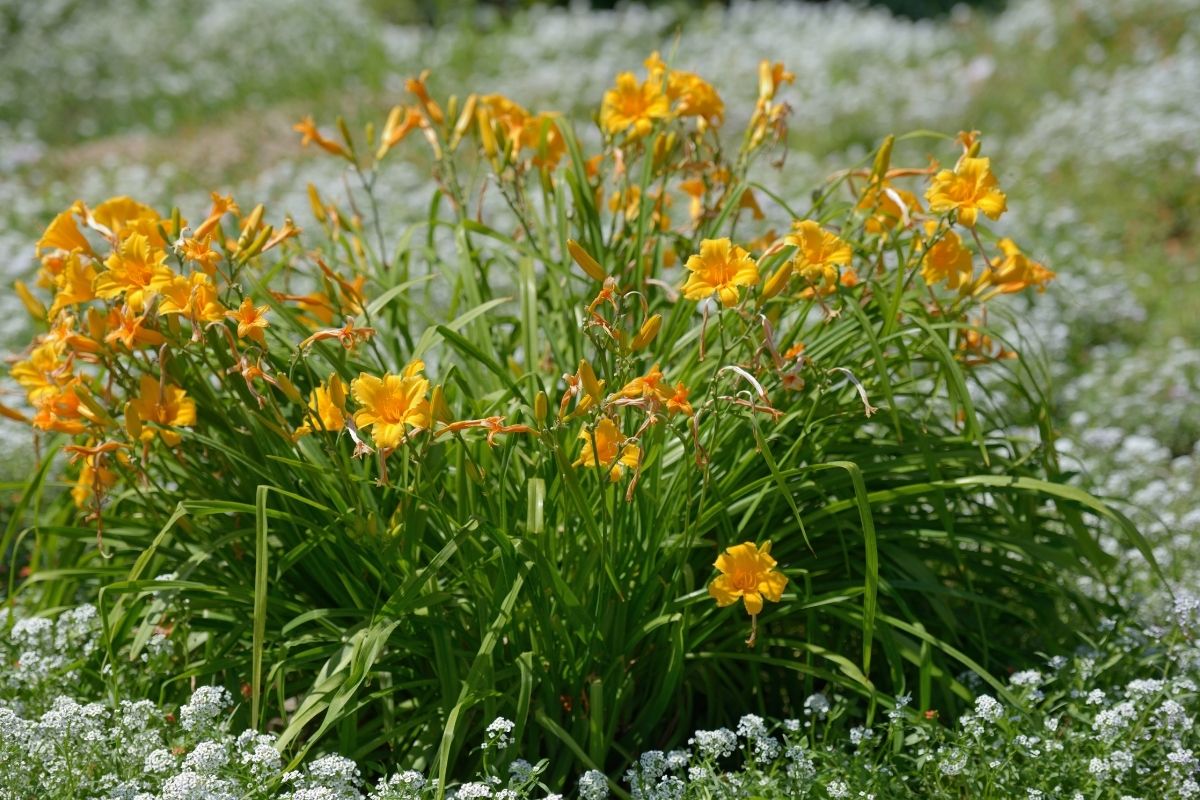
Few plants offer so many flowers in so many colors for so little effort. Tuberous, fleshy roots give rise to large clumps of arching, sword-shaped leaves that may be evergreen, semi-evergreen, or deciduous, depending on selection.
Clusters of flowers that look like lilies appear at the ends of generally leafless, wandlike stems that rise well above the foliage. Each daylily flower stays open for only one day.
Most daylilies bloom once a year, producing numerous flowers over a 3- to 6-week period. Other types can bloom again later in the summer and are called rebloomers.
11. Dead Nettle
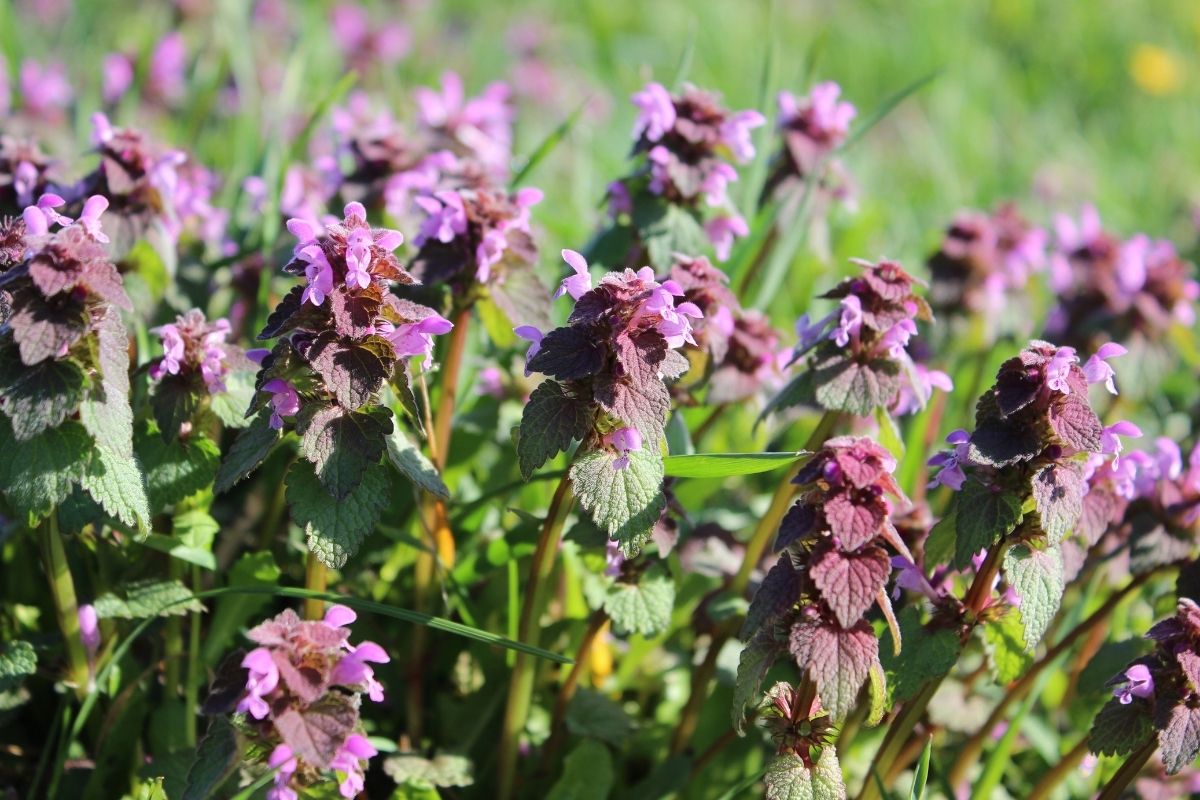
Native from Europe to western Asia. Heart-shaped, tooth-edged leaves, often marked with white or silver, are borne in opposite pairs; clustered flowers come in pink, white, yellow, lavender.
Vigorous growers thrive in shade; Lamium maculatum is used as a ground cover.
12. Delphinium
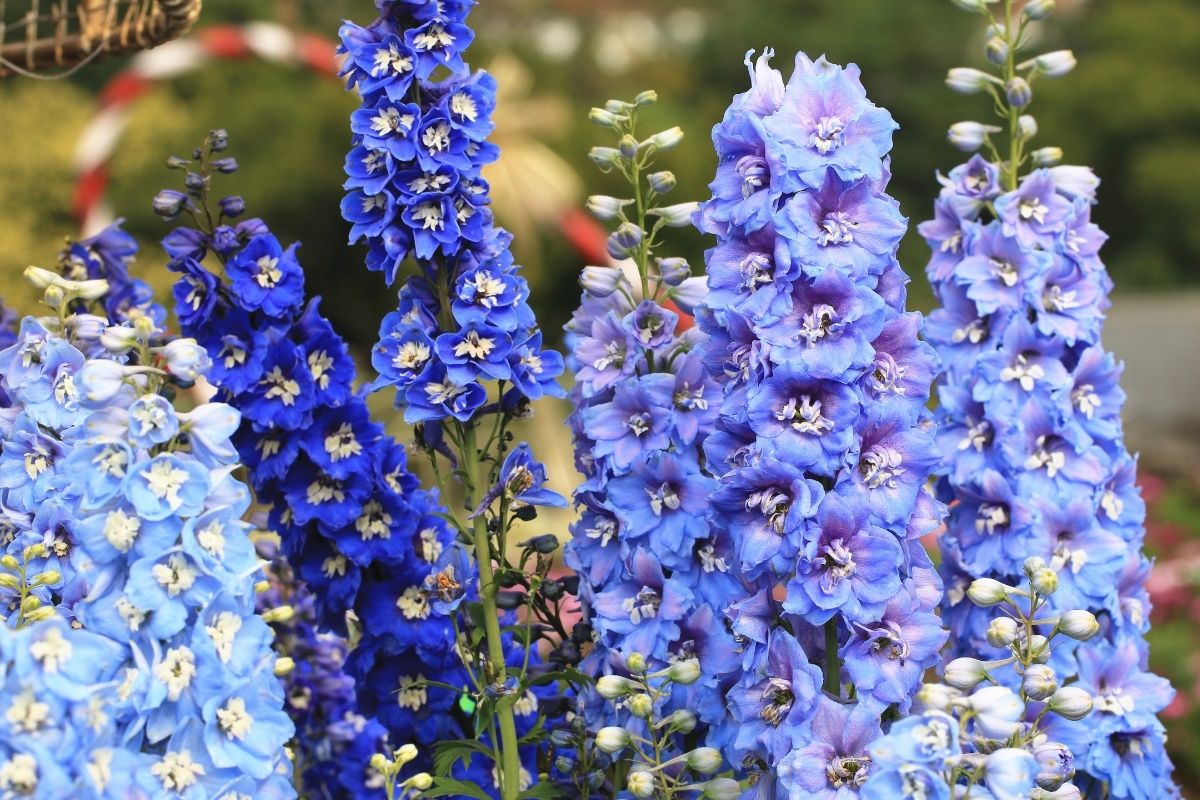
Often associated with the grand borders of England, stately delphiniums are problematic in most of the South. Those fancy hybrids (such as Delphinium elatum hybrids) can’t take our long, hot, humid summers and don’t often last more than a year or two.
In fact, they’re best treated as yearly. Native species may be less spectacular than the hybrids, but they are reliably perennial, rising up in the garden year after year.
13. Dendrobium

This huge species may include as many as 1,400 species and even more hybrids). It ranges from Japan and the Himalayas to Australia and the Pacific islands. Many are grown by orchid fanciers in greenhouses.
Some have thin, cane-like pseudobulbs, others short, fat ones. Only a few of the more widely grown are mentioned here.
Culturally, dendrobiums fall into two types. Intermediate-climate types are evergreen; they need water throughout the year (somewhat less in winter) and temperatures similar to those required by cattleya orchids.
RELATED: 30 Interesting Plants That Start With C (Including Pictures)
14. Desert Rose
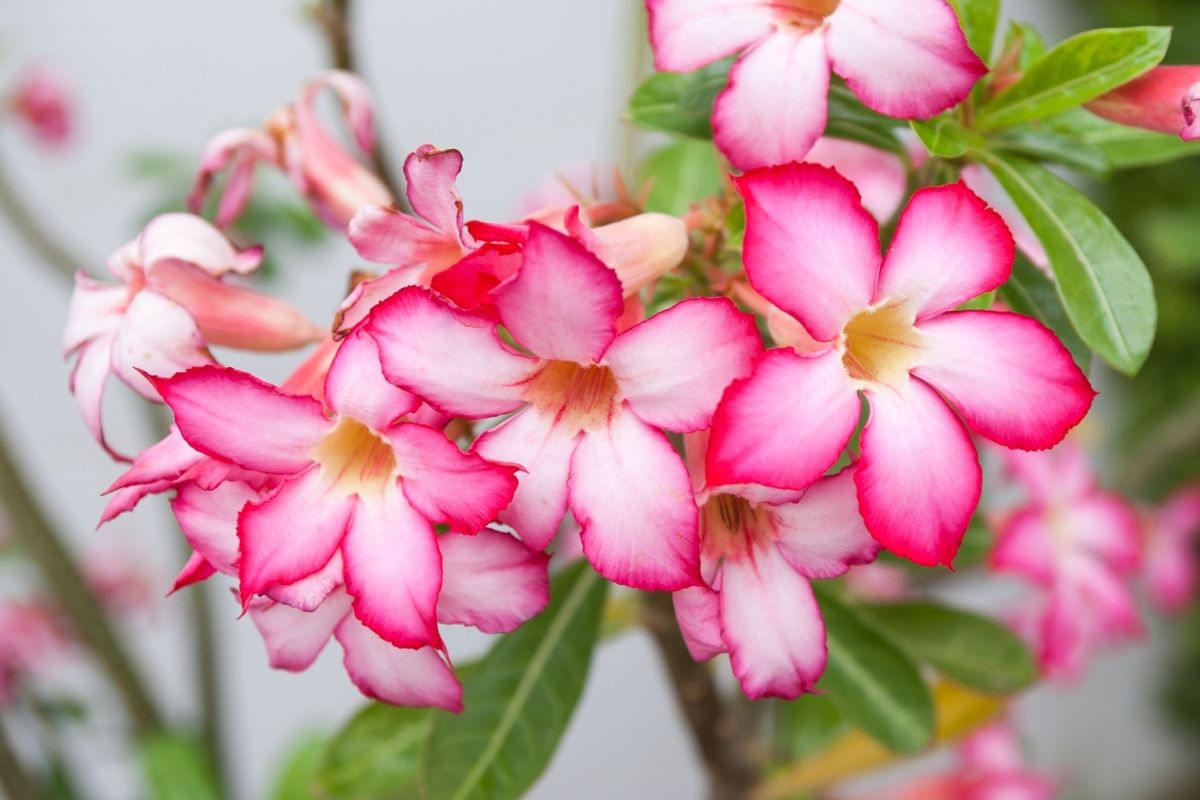
Called desert rose or desert azalea in its native tropical eastern Africa, this strange-looking plant has twisted trunks that emerge from a bulbous, swollen rootstock resembling a big onion.
Leafless for long stretches during dry periods, it redeems itself periodically throughout the growing season with greyish green, 4 inches-long leaves, and clusters of deep pink, red, or white, saucer-shaped, 2 inches flowers.
15. Desert Willow, Desert Catalpa
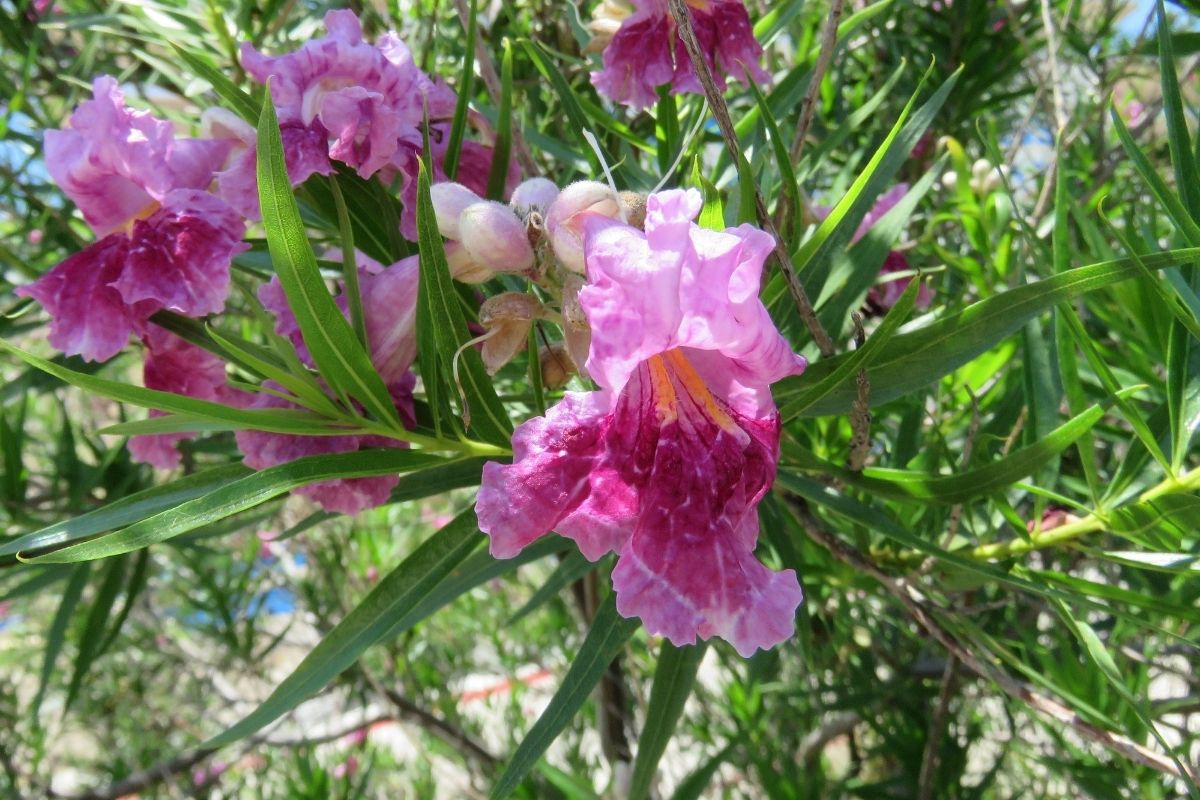
Native to desert and streambeds below 5,000 feet from California to Texas, south into Mexico. Grows 1530 feet tall, 10-20 feet wide; grows fast at first, then slowly.
With age, it develops shaggy bark and twisting trunks. Narrow, willow-type leaves grow to 25 inches long.
From spring to fall, produces fragrant, trumpet-shaped blossoms with crimped lobes, resembling those of catalpa or small cattleya orchids; flowers attract hummingbirds.
Flower color varies among seedlings; blossoms may be reddish-purple, lavender, rose, pink, or white, often marked with purple and gold. Nurseries select for good color, large size, ruffled form. Gallon-size plants can bloom in the first year.
Plant drops leave early and hold a heavy crop of catalpa-like seed pods through winter and can look messy. Thin growth to enhance picturesque shape.
Does best in dry, limey soil. Not for humid, high-rainfall areas. Look for the following recommended selections.
16. Deutzia
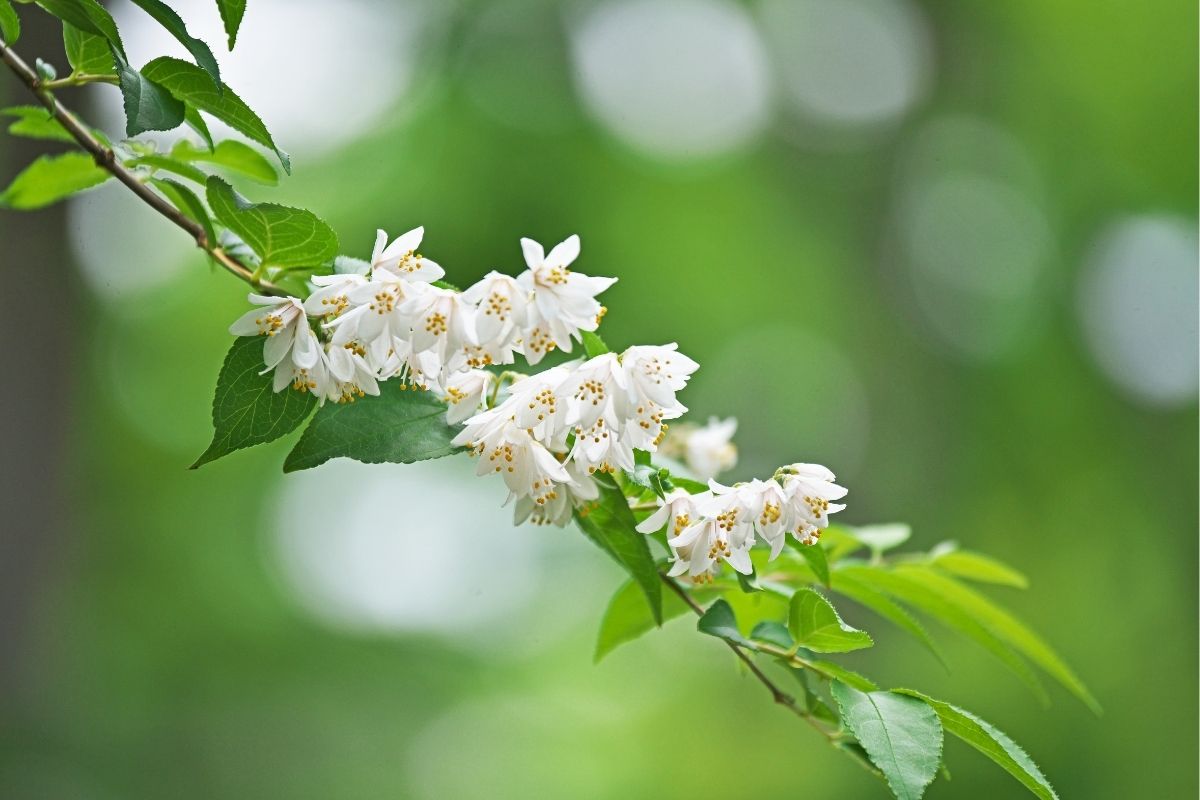
These shrubs are best used among evergreens, where they can make a show with their small, often fragrant flowers, then blend back in with other greenery later on. Bloom season coincides with that of late spring bulbs such as tulips and Dutch iris.
Prune as soon as flowers fade. With low- or medium-growing kinds, cut some of the oldest stems to ground every other year.
With tall kinds, prune heavily each year after bloom, cutting back wood that has flowered to outward-facing branches. Tough, easy to grow. Not browsed by deer.
17. Devil’s Backbone
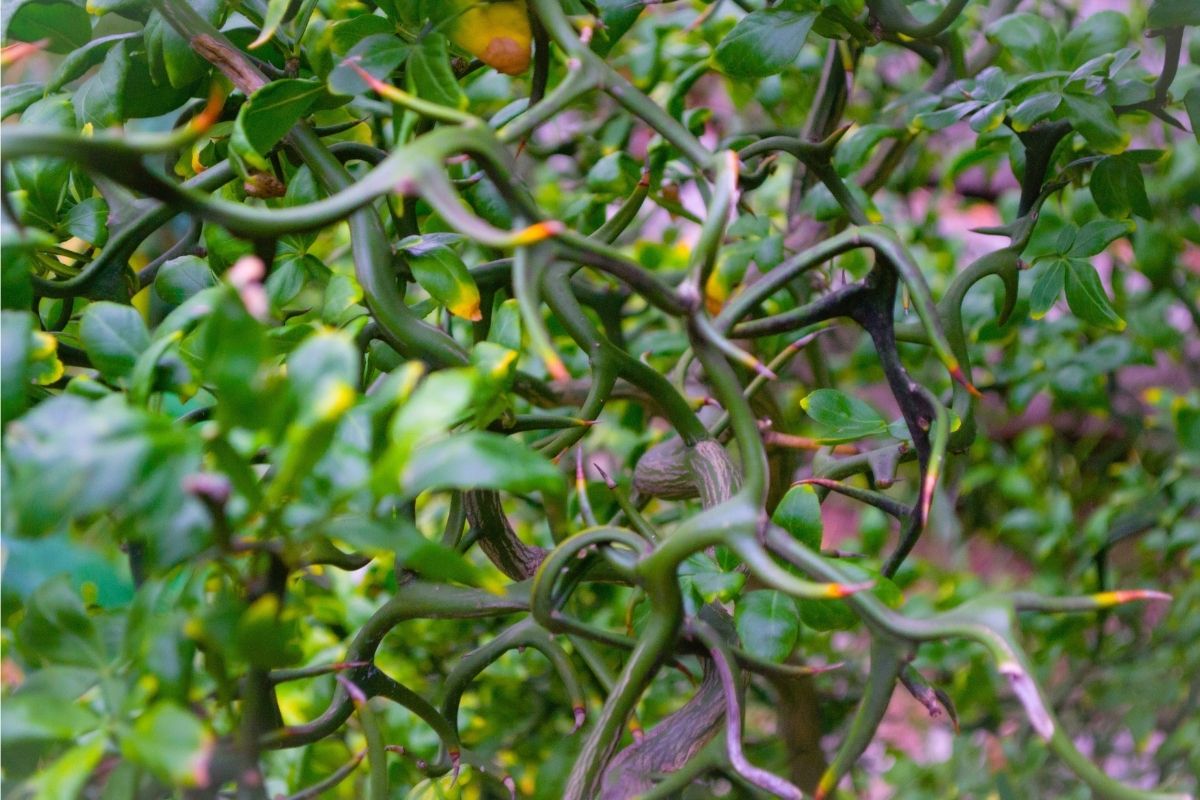
Native to the Caribbean, this bizarre plant is passed from gardener to gardener as a curiosity. It grows 3 feet tall and about half as wide, featuring succulent, zigzagging stems set with 3- to 6 inches long, medium green, diamond-shaped leaves.
If growing conditions are good, it may produce small red flowers in summer.
18. Dichondra Argenta
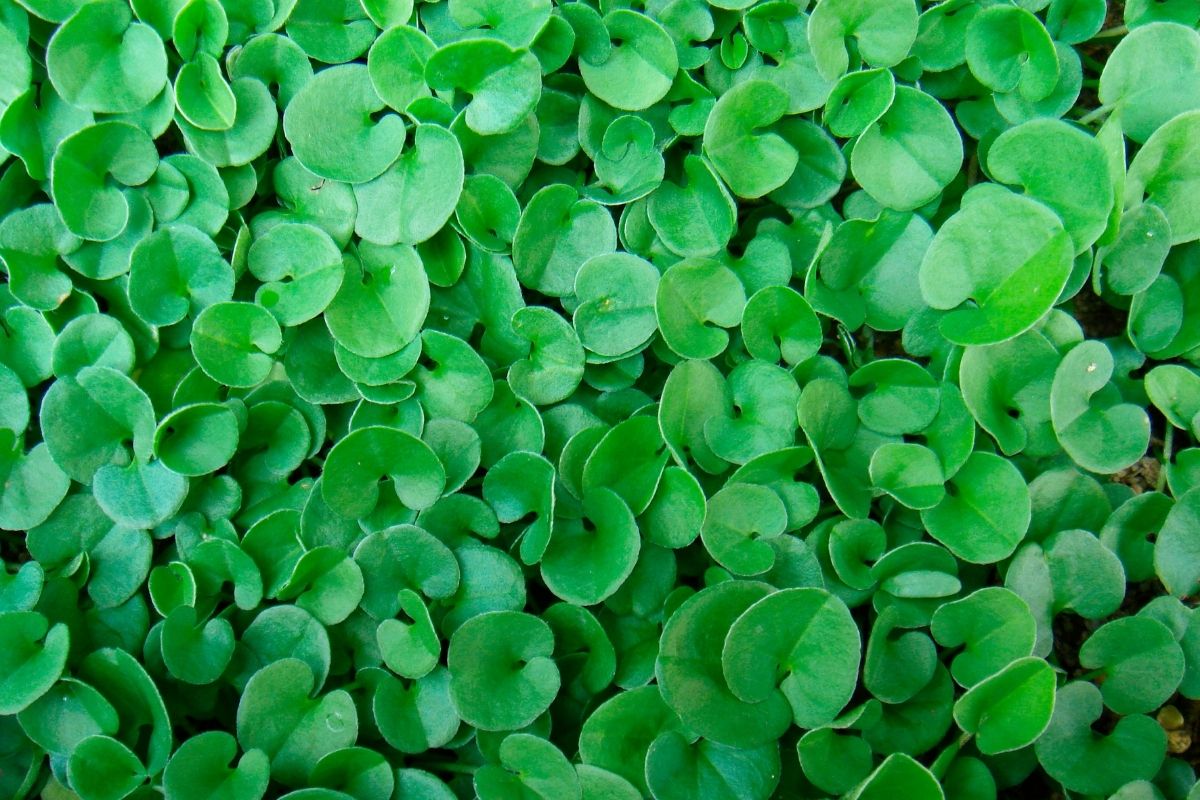
This low-growing foliage plant spreads by rooting surface runners. Grows 23 inches high and spreads 46 feet wide. Heart-shaped leaves are covered with silvery down, as are the stems.
Eye-catching, shimmering container plant; cascades over the edge of pots or window boxes. Can also be used as a small-scale ground cover. Easy to grow from seed. Use as an annual in cold-winter areas.
19. Dicksonia
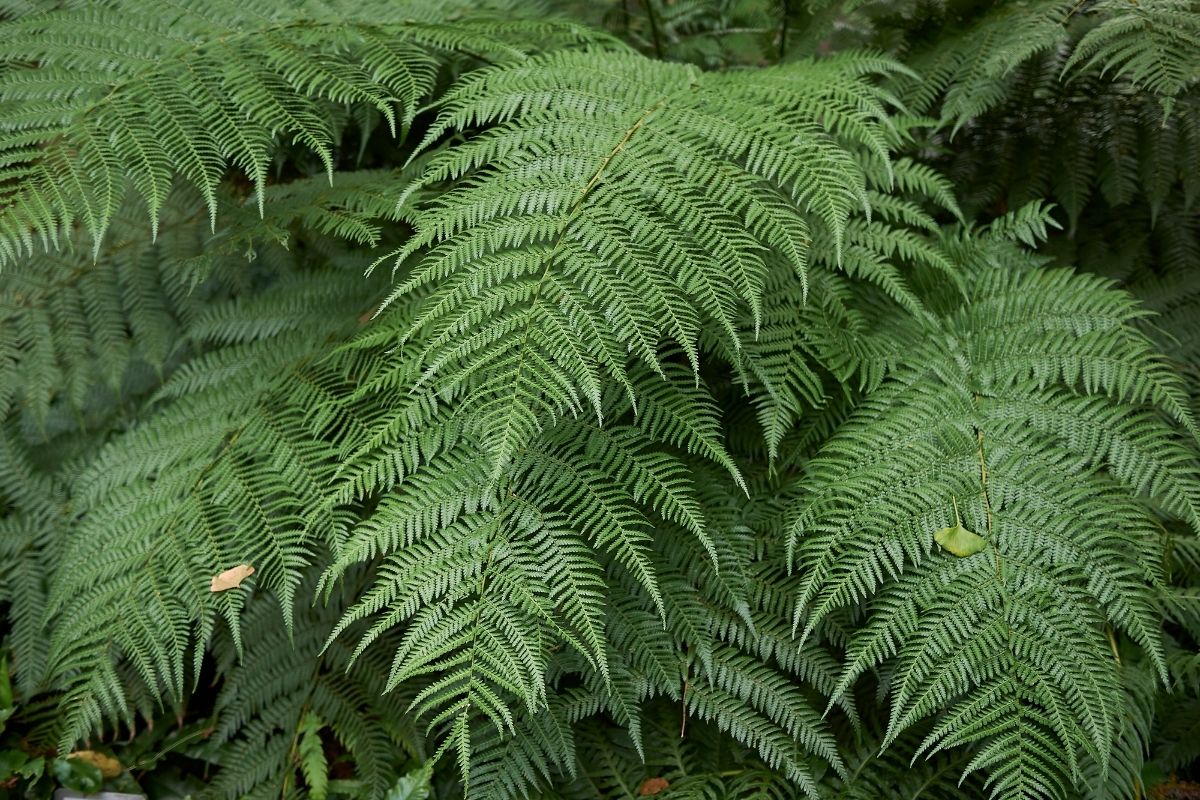
These hardy, slow-growing tree ferns from the Southern Hemisphere are easy to transplant and establish. Arguably the most beautiful of the tree ferns, they produce long, lacy, arching fronds.
Caring for them isn’t difficult. They need high humidity, so wet down the trunks on dry summer and autumn days. Overhead watering is preferred.
Give them moist, well-drained soil rich in humus; shield them from drying winds. Every spring spread a few inches of organic fertilizer, such as garden compost or composted cow manure, around the base.
20. Dicliptera
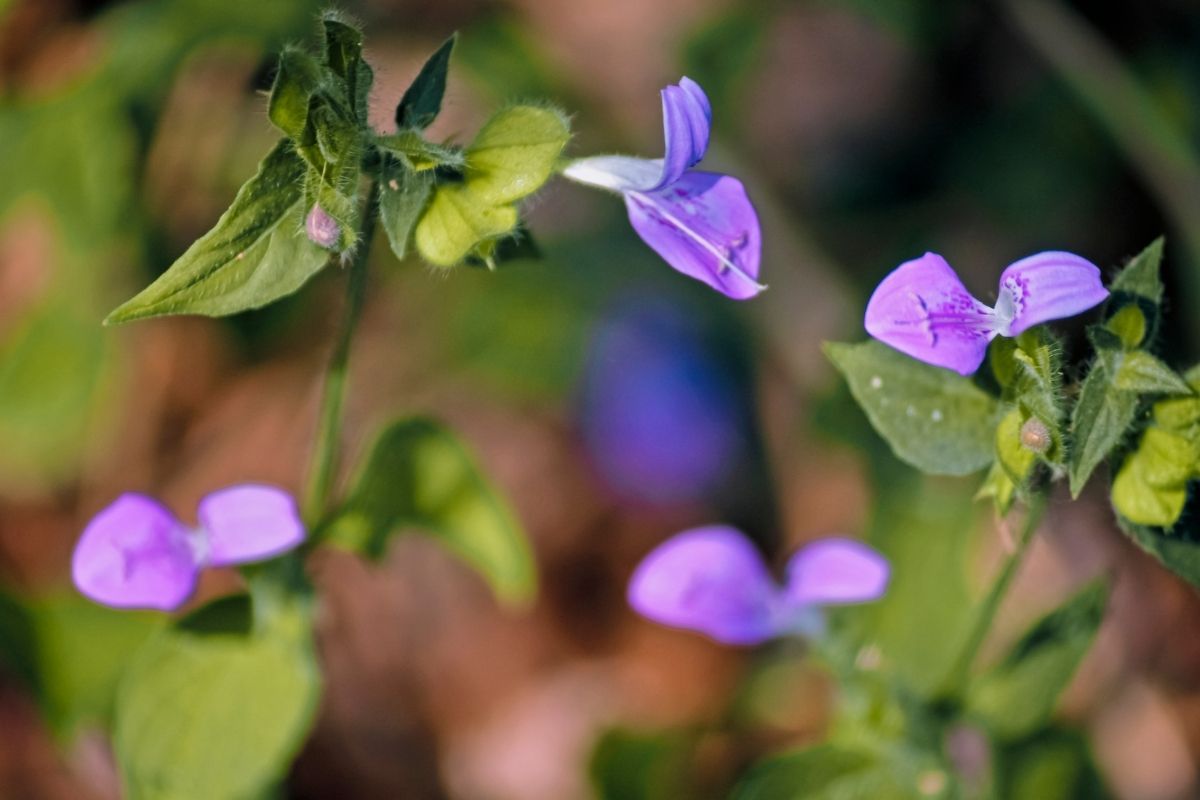
These tender, shrub-like perennials offer colorful tubular blooms from spring to fall. They hold up well in heat, but they must have good drainage.
Where stems are not killed to the ground by frost, shear to about 6 inches high in late winter.
21. Dill
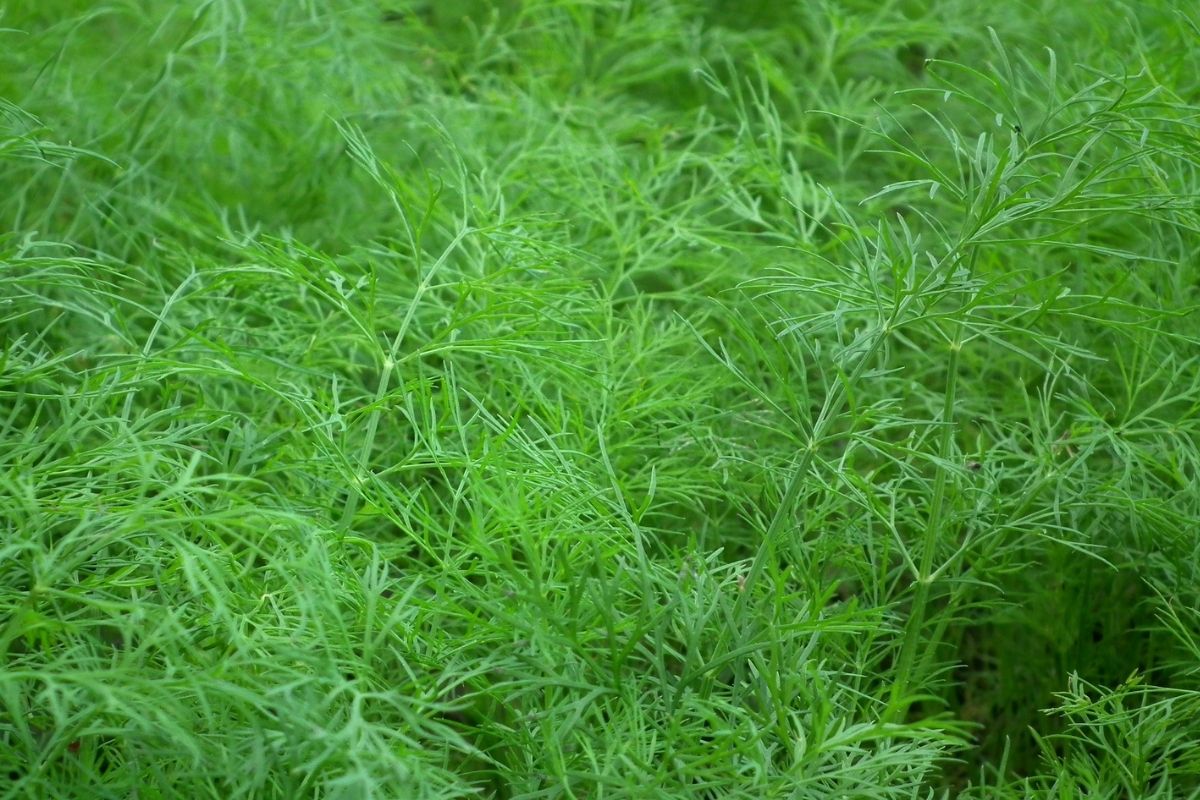
Aromatic herb to 34 feet tall. Soft, feathery leaves; umbrella-like, 6 inches-wide clusters of small yellow flowers. The seeds and leaves have a pungent fragrance.
Sow seed where the plants are to be grown; for a constant supply, sow several times during spring and summer (germinates and grows better in spring than in summer).
22. Dioon
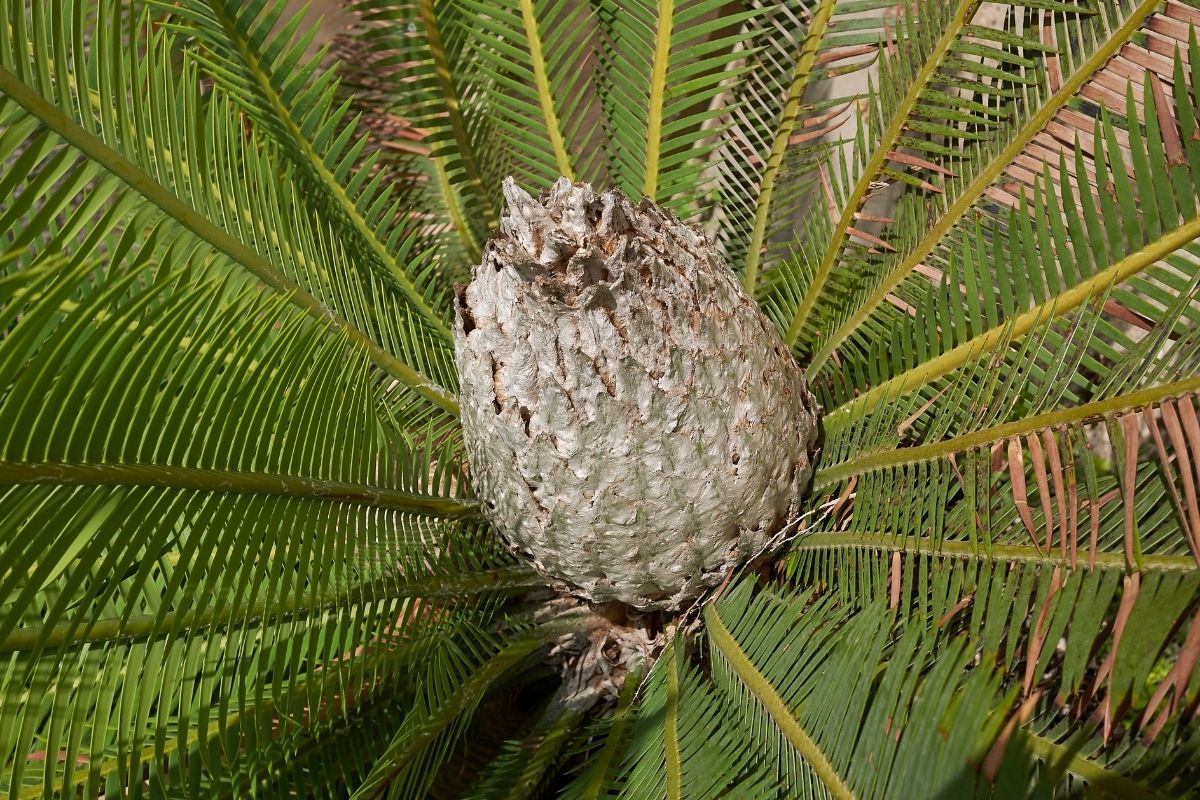
These cycads resemble Cycas revoluta, but they are less widely sold, more tender, and have even slower growth. Male and female plants are separate.
Dioons are excellent choices for tropical effects and as container plants. Native to the American tropics, these living fossils have changed little in 200 million years. Not browsed by deer.
23. Disanthus
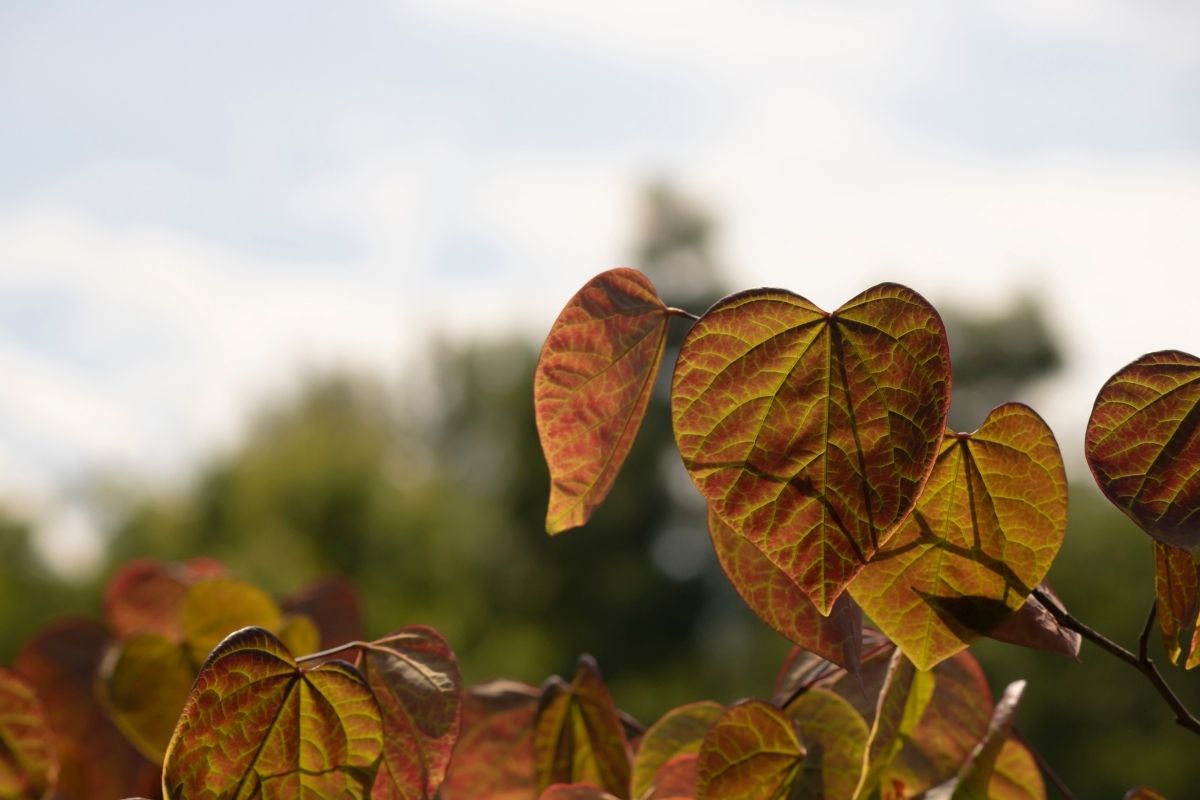
Native to Japan. Slender-branched shrub to 1012 feet tall and wide, grown for magnificent fall color.
Nearly round, smooth, 2- to 4 inches-wide leaves turn from bluish-green to shades of deep red with orange tints at the onset of colder weather.
Tiny, purplish fall flowers are mildly fragrant. Provide rich, acidic, moist soil and protection from wind. No special pruning is needed.
24. Distictis
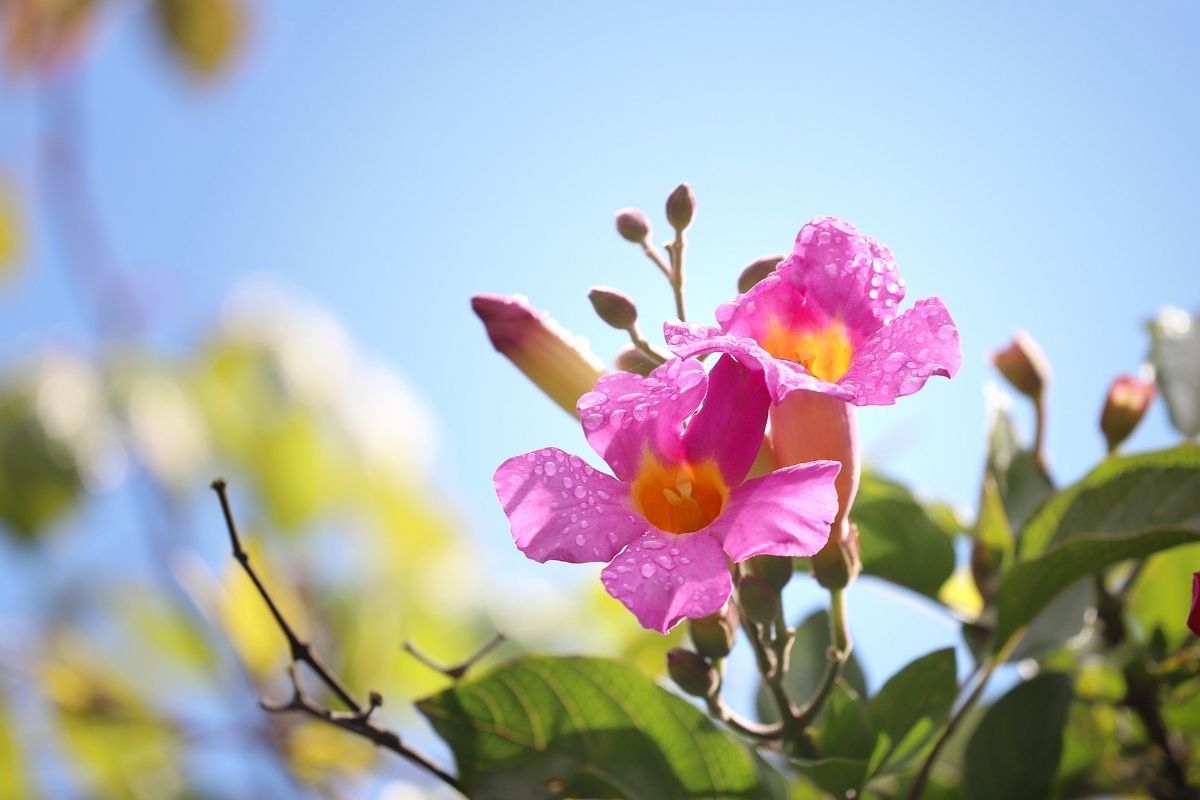
These Mexican natives are spectacular vines for milder climates, reaching heights of 2030 feet Glossy leaves consist of two leaflets with a central, three-part tendril that plants use for climbing.
All bear long-lasting, trumpet-shaped flowers. Plant in good, well-drained soil; provide sturdy support, since growth is dense and heavy. Prune in winter to thin stems, control size. Not browsed by deer.
25. Dogwood
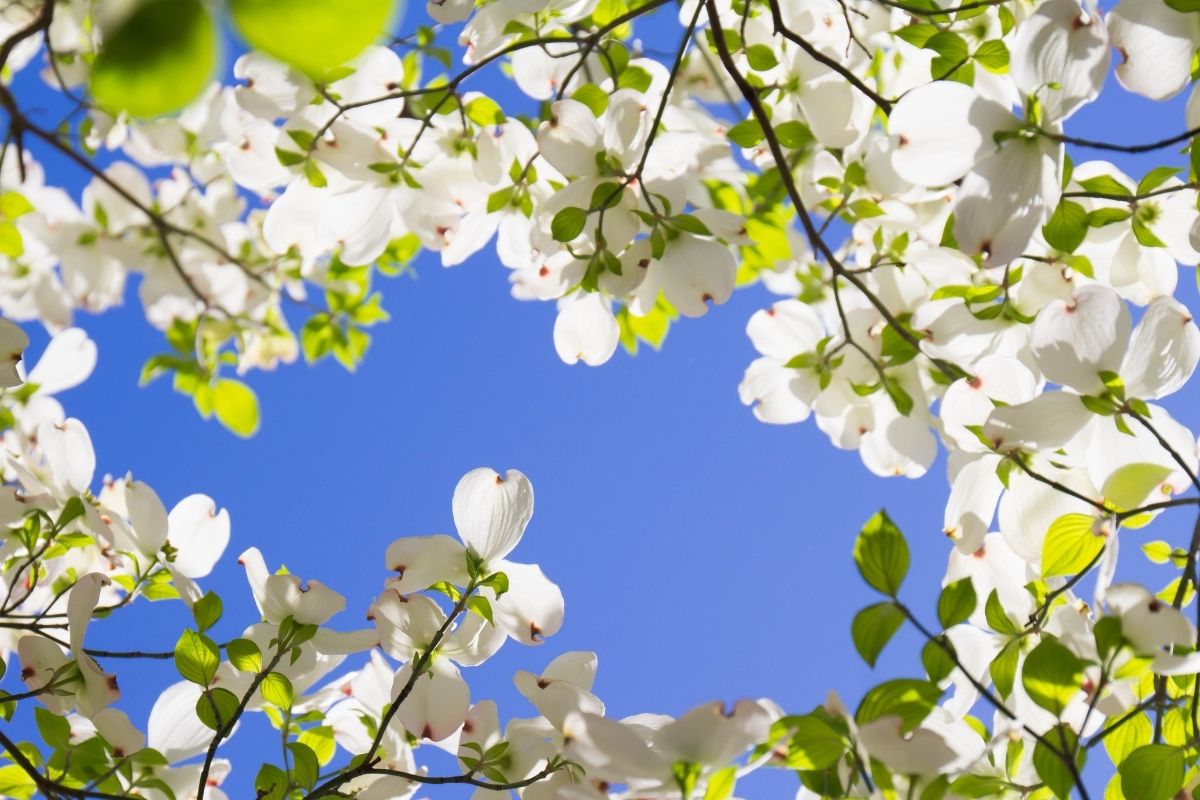
For many Southerners, there’s only one dogwood: flowering dogwood (Cornus florida), widely considered the region’s finest ornamental tree.
But many types of dogwood exist, from good-sized, single-trunked trees to small, multi-stemmed, stoloniferous shrubs; there’s even a ground-covering perennial dogwood.
Some are spectacular in bloom, others barely noticeable. Some sport dazzling fall foliage; others don’t.
RELATED: 9 Mesmerizing Plants That Start With M (Including Pictures)
26. Douglas Fir
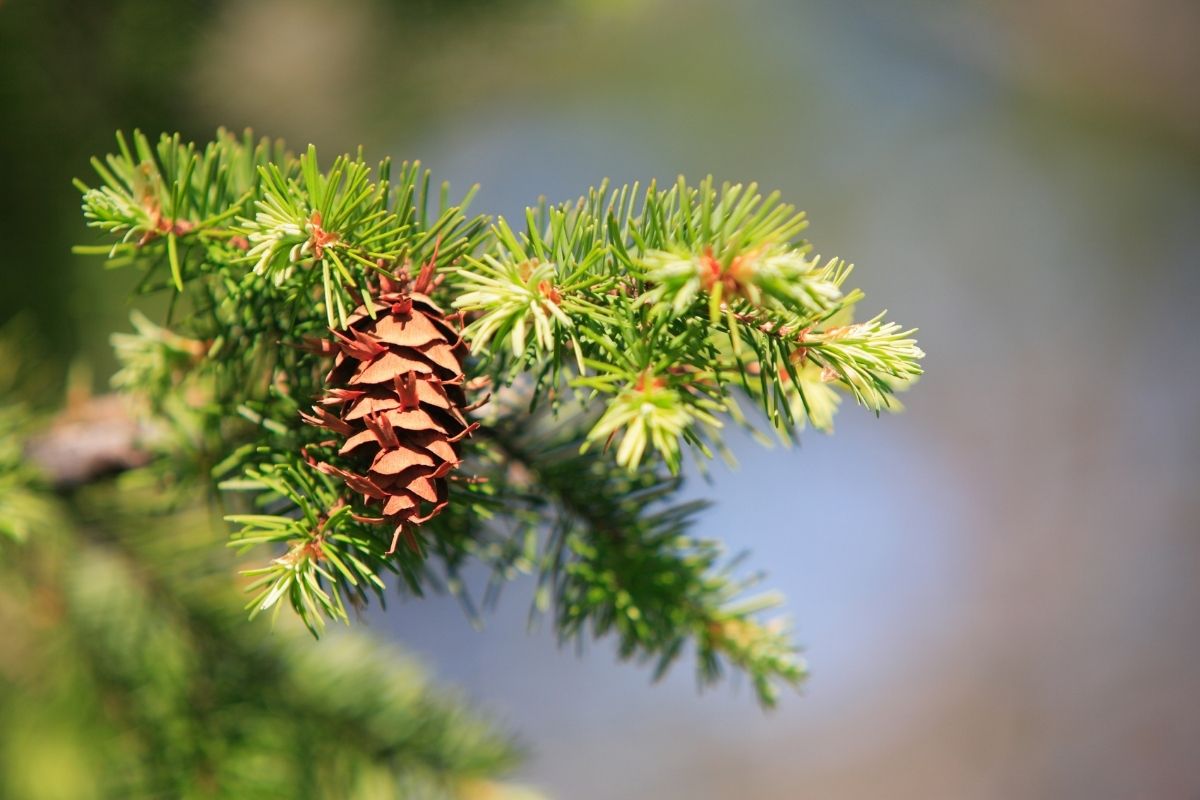
Popular as a living or cut Christmas tree. It reaches 70200 feet tall in Western forests; in gardens, it is more likely to grow 4080 feet tall and 1220 feet wide.
Trees are cone-shaped and foliaged to the ground when young, but lose lower limbs as they age. Soft, densely set, green or blue-green needles to 1 inch long radiate in all directions from the branches; they give off a lemon scent when crushed.
Pointed, wine-red buds form at branch tips in winter, then open to apple green new growth in spring.
Reddish-brown, oval cones are about 3 inches long, with three-pronged bracts. Unlike upright cones of true firs (Abies), these hang down.
27. Dove Tree
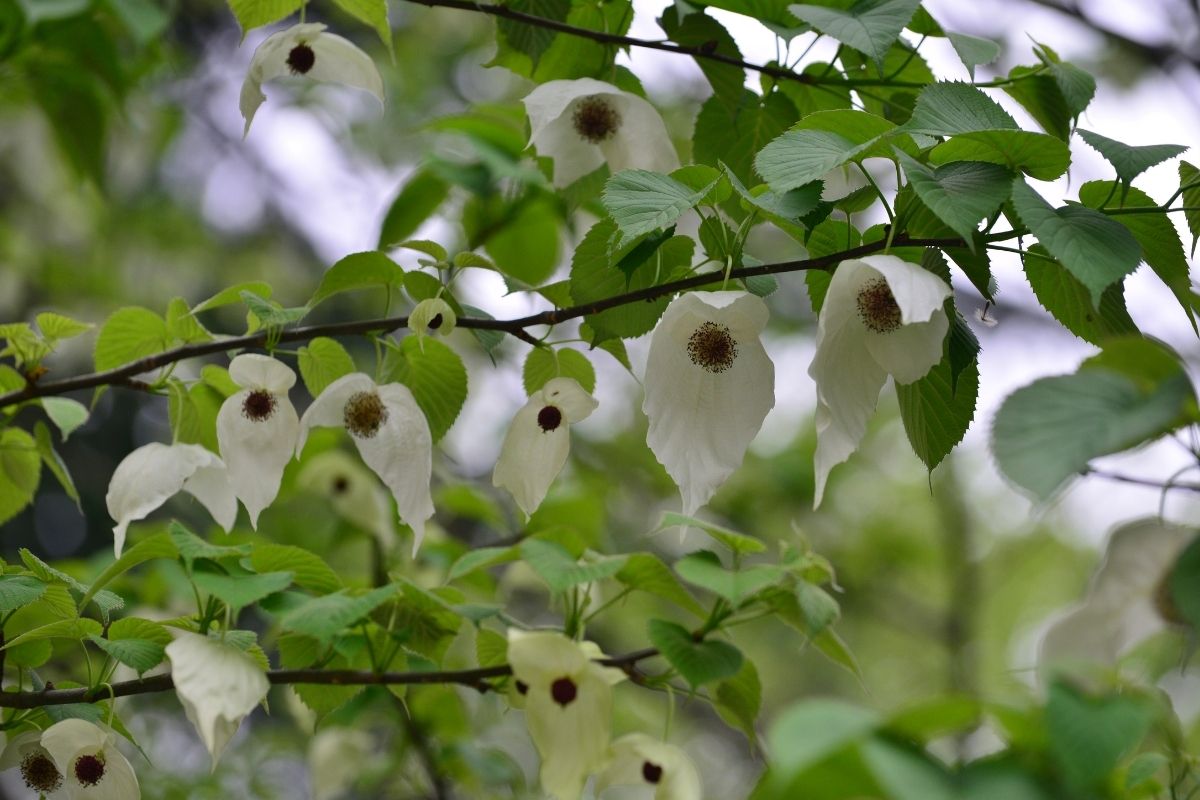
Native to China. This is one tree you crow about if it blooms in your garden. In gardens, it grows 2040 feet tall, 1225 feet wide, with a pyramidal rounded crown and strong branching pattern.
Has a clean look in and out of the leaf. Roundish to heart-shaped, 3- to 6 inches-long leaves are vivid green.
Comes into bloom in spring; the general effect is that of white doves resting among green leaves (or handkerchiefs drying on branches). Small, clustered, red-anthered owners are carried between two large white or creamy white bracts of unequal size (one 6 inches long, the other about 4 inches long).
Trees often take 10 years to come into power, they may bloom more heavily in alternate years. No fall color. Brown fruit about the size of golf balls hangs on trees well into winter.
28. Dracaena
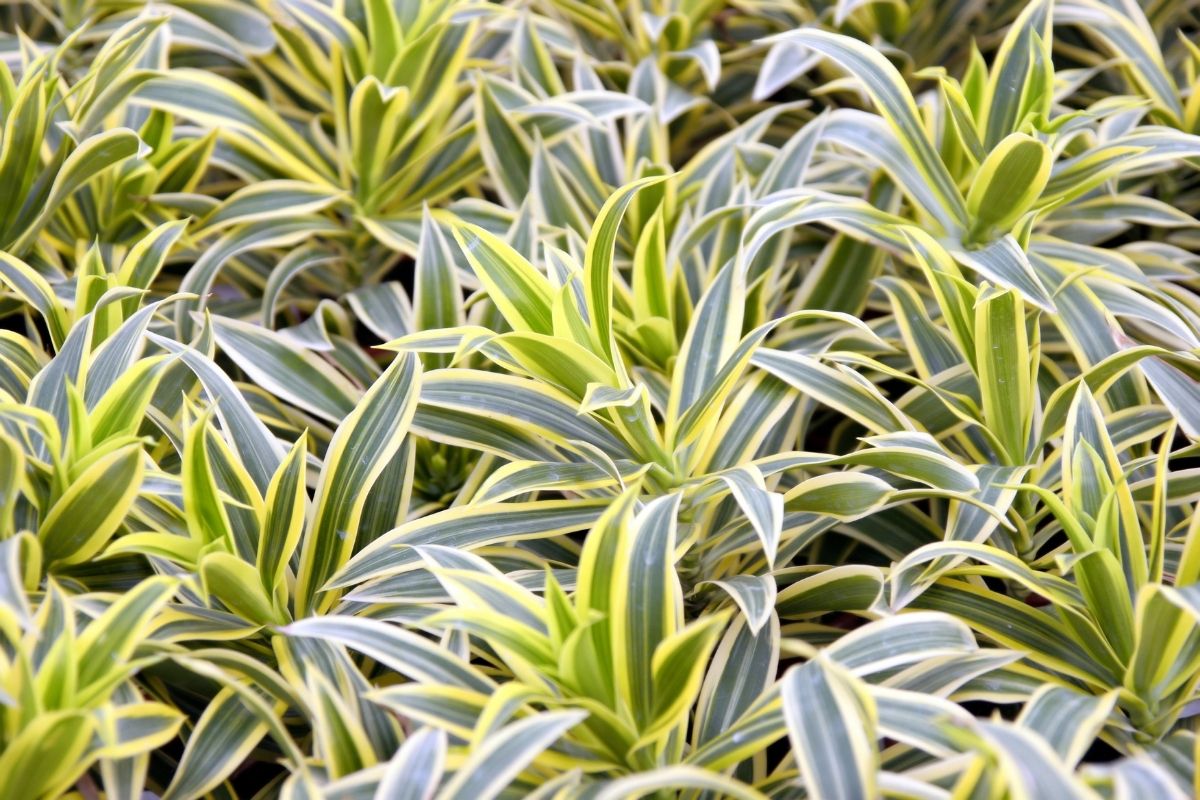
About 40 species of tropical trees and shrubs. Although they’re hardy outdoors in the Tropical South, most people grow them indoors.
Some species and selections display graceful, fountainlike forms with broad, curved, ribbonlike leaves that may be striped with chartreuse or white; others bear stiff, sword-like foliage.
29. Dropseed

Don’t let the graceful appearance and fine texture of these clumping grasses fool you; they’re as tough as they come.
Deep-rooted and drought-tolerant; excellent for massing in hot, dry areas and effective in meadow gardens, mixed borders, naturalized areas, rock gardens, even swimming pools.
Plumelike flower heads appear in summer or fall; after they fade, tiny seeds drop to the ground, hence the common name.
30. Drumsticks
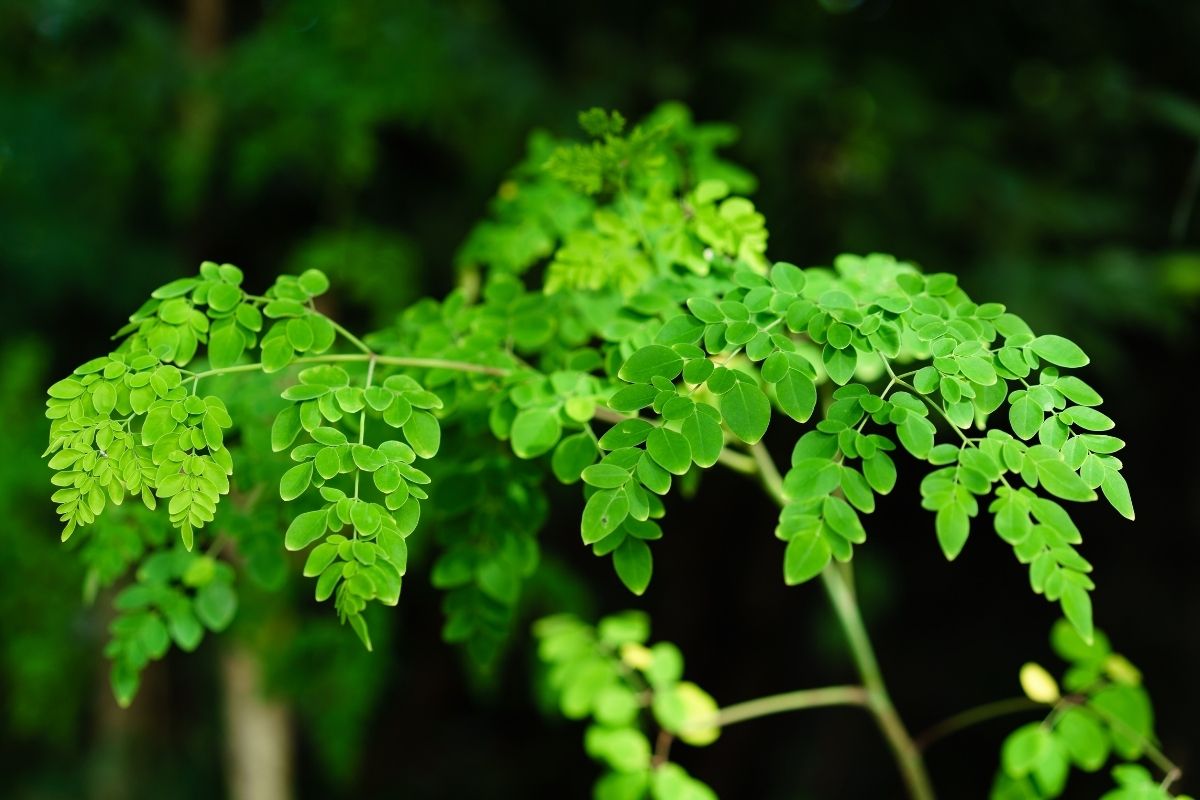
Odd, attractive, offbeat Australian daisy. Silvery leaves form 8- to 12 inches-wide clumps, send up 2 feet stalks, each topped by a 1-inch globe of tiny yellow flowers.
Bloom may occur at any time of year. Flowers are useful, fresh or dried, in arrangements.
31. Dumb Cane
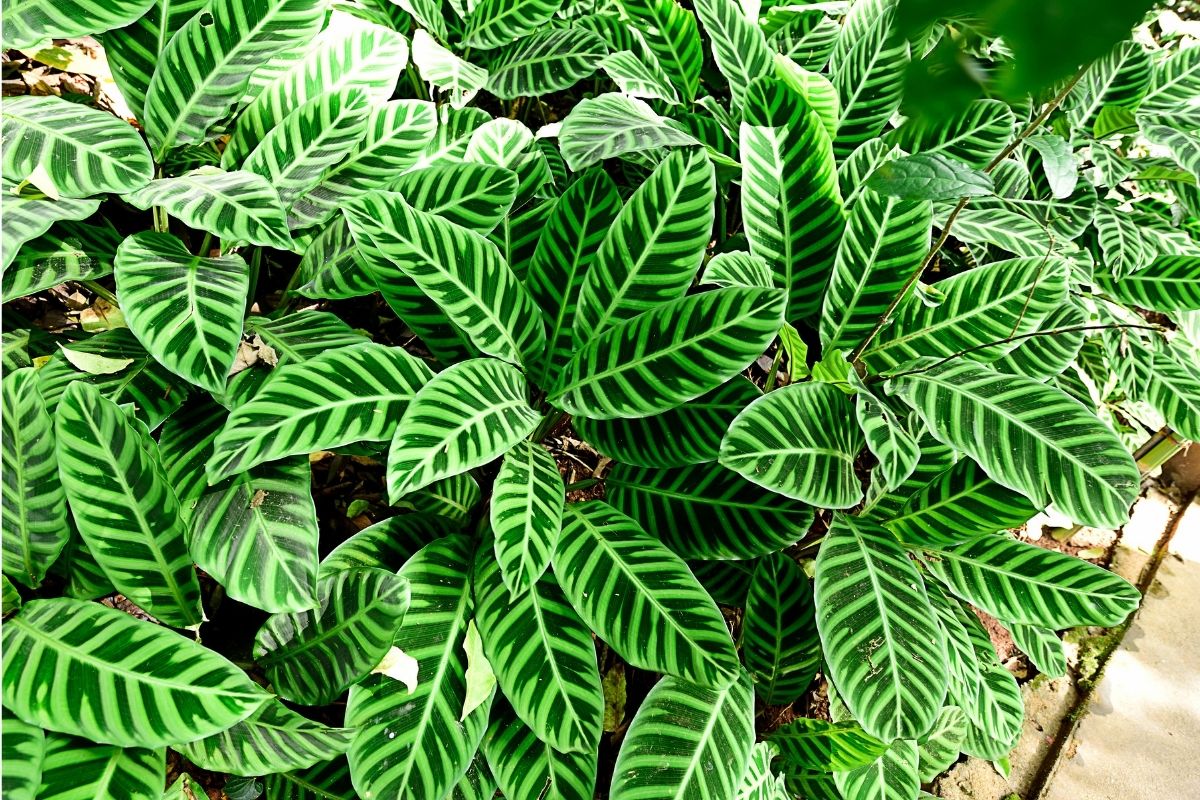
From forests of the tropical Americas. Grown for their striking evergreen foliage in colors varying from dark green to yellow-green and chartreuse, with variegations in white or pale cream.
The Tropical South will grow year-round outdoors, either potted or in the ground as accent plants.
Elsewhere, grow them indoors. Young plants generally have single stems, while older ones may develop multiple stems.
Taller than wide; those listed here are 12 feet wide. Mature plants bear flowers resembling odd, narrow Callas (Zantedeschia).
32. Duranta
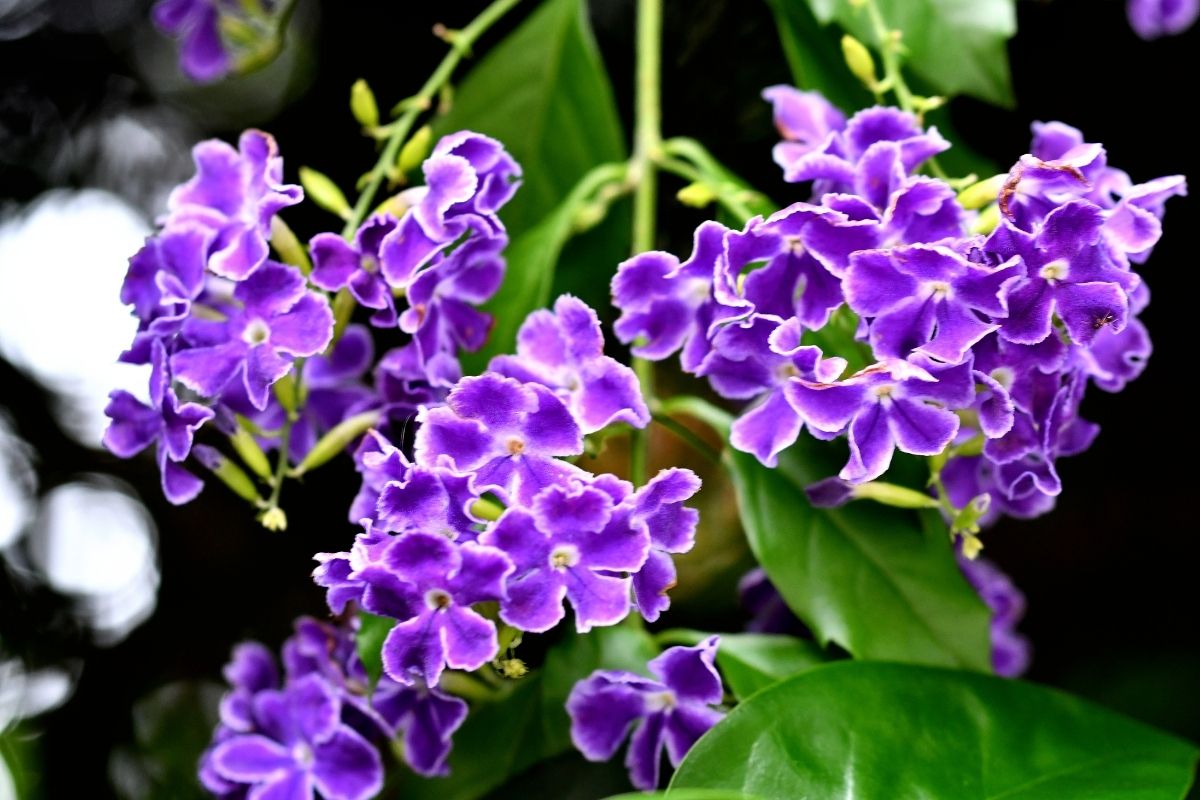
These tender flowering shrubs feature glossy green leaves arranged in pairs or whorls along stems. Attractive blue or white flowers in clusters attract butterflies in summer, followed by bunches of berry-like yellow fruit.
Plants marketed as Duranta stenostachya are often actually Duranta erecta; distinguishing characteristics are described below. Use a quick, tall screen. Thrive in heat. Need continual thinning and pruning to stay under control. Good container plants.
33. Dwarf Morning Glory
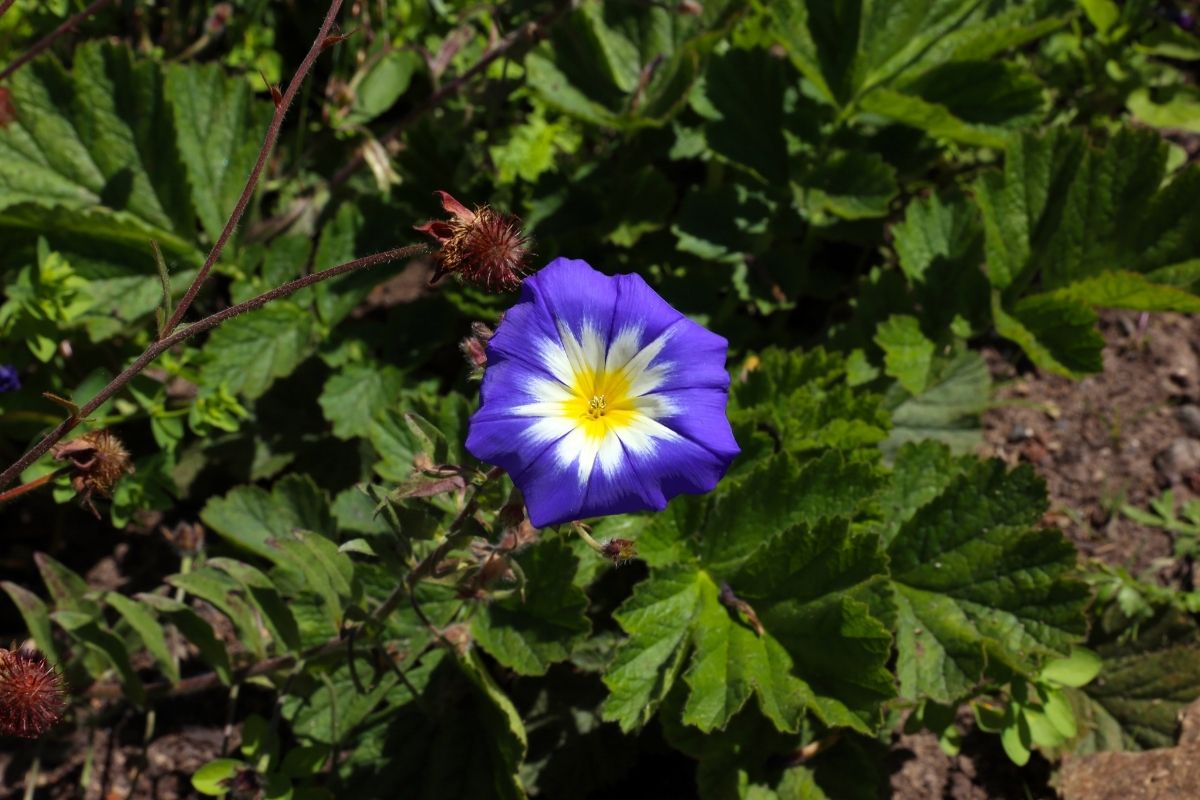
Thanks to its brightly colored, funnel-shaped flowers, this old-fashioned European native is often confused with morning glory (Ipomoea tricolor), a twining vine of the tropics.
Dwarf morning glory, however, doesn’t climb and its flowers stay open all day, unlike those of its familiar relative. A traditional (if somewhat forgotten) bedding plant, it is excellent for massing, edging, hanging baskets, or containers.
Forms a bushy, slightly trailing mound to 1216 inches high and 2 feet wide, with narrow, dark green leaves to 1 inch long.
Blooms profusely in summer, covering itself with striking, 1- to 2 inches-wide flowers in royal blue, red, pink, or white, all with a yellow-and-white starburst pattern in the throat. Plants in the Ensign series are compact and free blooming.
34. Dyer’s Woad
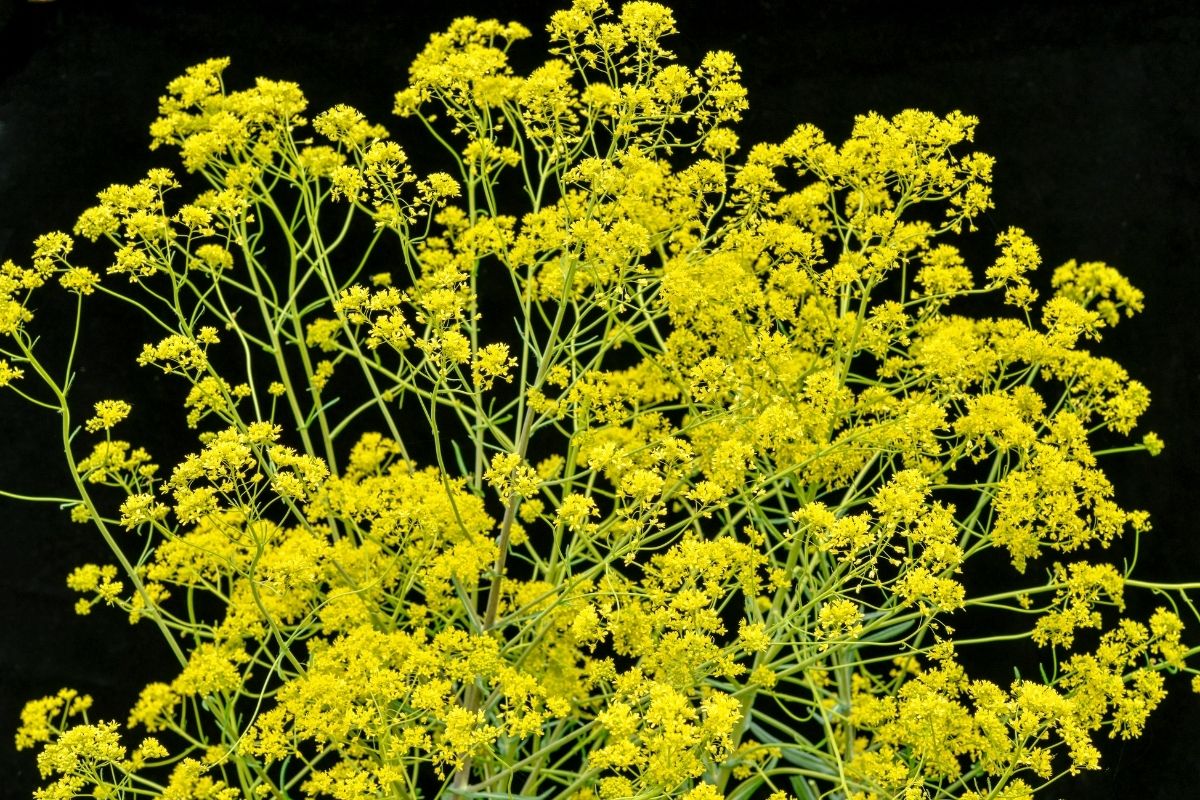
Known since pre-Christian times as a source for deep blue dye (it is extracted from the foliage), this plant was probably imported into the U.S. by European colonists in the late 17th century.
It quickly spread by seed and is now considered a weed in many dry Western states. In the South, however, it’s less likely to become weedy and makes a fine addition to a mixed herbaceous border. Bluish-green, 8 inches-long basal leaves grow in clumps from a thick taproot.
Flowers usually come in April and May of the second year, when the plant sends up 2- to 4 feet-tall stems tightly clasped by lance-shaped, blue-green leaves with white midveins; blossom stalks branch off near the stem tops, bearing large (up to 1 feet-wide) clusters of small, bright yellow blooms.
Deep purplish-black seed pods form after the flowers fade.
Conclusion
We have gone through 36 different plants beginning with D! That’s a lot of plant information to absorb.
Whether it’s the classic daffodil that tickles your fancy, or the Caribbean-born Devil’s Backbone, there is a wide range of plants here from all over the world to suit anyone and everyone.
Hopefully, you have found what you are looking for. Happy planting and good luck!







